
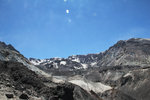
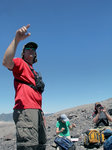
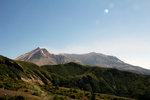
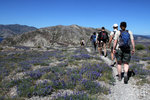
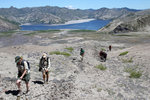
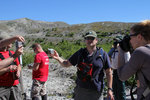
Hiking is a relatively inexpensive hobby that gets people active and outdoors, taking them nearer to nature than a drive down U.S. Forest Service roads to Windy Ridge at Mount St. Helens can.
While hiking trails from the parking lot at Windy Ridge are open to the general public, those willing to spend some cash for a guided, off-trail adventure can get an even closer look at the volcano’s crater, its domes and Crater Glacier while learning about the volcano.
The Mount St. Helens Institute shared the typically $195 experience with members of the media, including a Chronicle reporter, on Thursday. It has been offering the hike for three years.
Scientists with the organization take hikers to a viewpoint only available via the tour where participants can look into the crater from its edge and see one of the youngest and only growing glaciers in the world — Crater Glacier.
The glacier formed after the 1980 eruption and has two arms that come down on either side of a lava dome that was created during the 2004-08 eruption.
Peter Frenzen, monument scientist and public affairs officer with the U.S. Forest Service, said the glacier’s advancement is slowing, and will likely reach equilibrium soon.
Scientists discovered the glacier’s growth about seven to nine years after the eruption. In 2006, it was named Crater Glacier. Previous to its official naming, the name Tulutson, the Cowlitz word for ice, was suggested.
The Washington State Board of Geographic Names chose Tulutson over three other options. However, the U.S. Board on Geographic Names chose Crater Glacier.
While the glacier view may be the destination of the hike, the entire journey is brimming with beauty, science, history and culture.
The about 8-mile roundtrip hike begins on Truman Road. The road used to lead to the Timberline viewpoint that was destroyed in the 1980 eruption. Hiking 2 miles on the wide road with minimal ups and downs is easy and offers vast views of area including neighboring volcanoes.
From the former Timberline area, Ray Yurkewycz, Mount St. Helens Institute director of operations, led the group on the Windy Ridge Trail. The path that would be considered a standard width hiking trail led through fields of purple lupine in their peak blooming stage one month early due to the mild winter and spring.
The lupine fields are visible as dull purple-gray splotches all over the Pumice Plain, and their sweet scent is carried in the air throughout the area.
Lupine was one of the first plant species to return to the Pumice Plain, the area below the volcano where “absolutely nothing survived,” Frenzen said. The plants provide a nutrient-rich net, allowing other seeds that land on the plain to get started, leading to the regrowth of a rich and diverse ecosystem.
While the dry, hot weather has dried up some regular water holes, it hasn’t dried up the stream from the glacier that cuts across the trail and is surrounded by willows on both sides. The water is drinkable and hikers did fill bottles; however, the guides advised everyone to carry three liters of water for the hike.
The Windy Ridge Trail is also fairly flat, but is interrupted with a few washouts. Hikers should watch their steps and give those below trail from them a safe amount of space to make sure they don’t get struck by rocks knocked loose.
The last mile of the hike is off trail and gains about 1,000 feet of elevation. It starts on a hard, dark lava flow about 2,000 years old, forming near the same time as the Ape Caves lava tubes south of the volcano.
During the climb up multiple mountain goats, including kids, could be seen climbing the Sugar Bowl Dome, a lava dome formed between 850 and 900 common era.
Last year scientists did their first survey of the goats and counted a minimum of 65. Another survey is planned for later this summer.
Yurkewycz said the mountain goat population has increased from a handful 10 years ago to the dozens that roam the area today.
While traversing the lava flow is easy, soon rocks and ash make the climb difficult; with each step forward, hikers slide back slightly.
After the challenging final stretch, hikers reached the crater’s edge at about 5,200 feet. The point offers a view of a strange, scientific wonder. Crater Glacier formed by the 1980 eruption, reaching both arms around, hugging the 10-year-old dome formed by this century’s eruption that somehow did not have much of an impact on its icy counterpart.
From the glacier, a the Loowit Stream flows away, and rocks and ash fall, signs that an eruption isn’t required to change the crater’s landscape.
Two North County Emergency Medical Response Volcano Rescue Team members also made the hike last week and talked to reporters about why people are not allowed to hike in the crater.
Paul Pepper, with the rescue team, recounted a trip into the crater, explaining the tough work and treacherous terrain makes the hike too dangerous to allow people to make.
“We went in to basically see if there was a route to get people out if they got injured,” Pepper said. “... But it is live in there. Everything moves.”
Safety, along with the desire to preserve the landscape and not impede research, are the reasons why hikes near to the crater require permits and guides.
Frenzen explained that not only is Mount St. Helens one of the most studied volcanoes in the world for its activity, but also for its ecosystem and the life that has come back on the Pumice Plain.
Scientists from all over the world come to study data collected from the stretching and compressing of the crust, seismic activity, acoustic flow, among other things including the rebirth of multiple species.
“Lessons learned at Mount St. Helens are applied around the world,” Frenzen said.
The funds from these hikes go toward education programs provided by the Mount St. Helens Institute and scientists’ work at the volcano.
With the programs offered, the organization hopes to share their love of science, especially with children.
The volcano offers a “tremendous teachable moment” where people learn that the world is an unstable place, Frenzen said.
“Even if you don’t care about science, you start to care about it here,” Yurkewycz said.